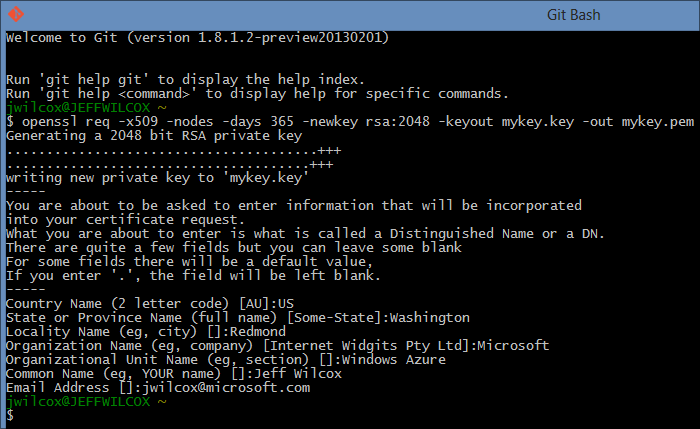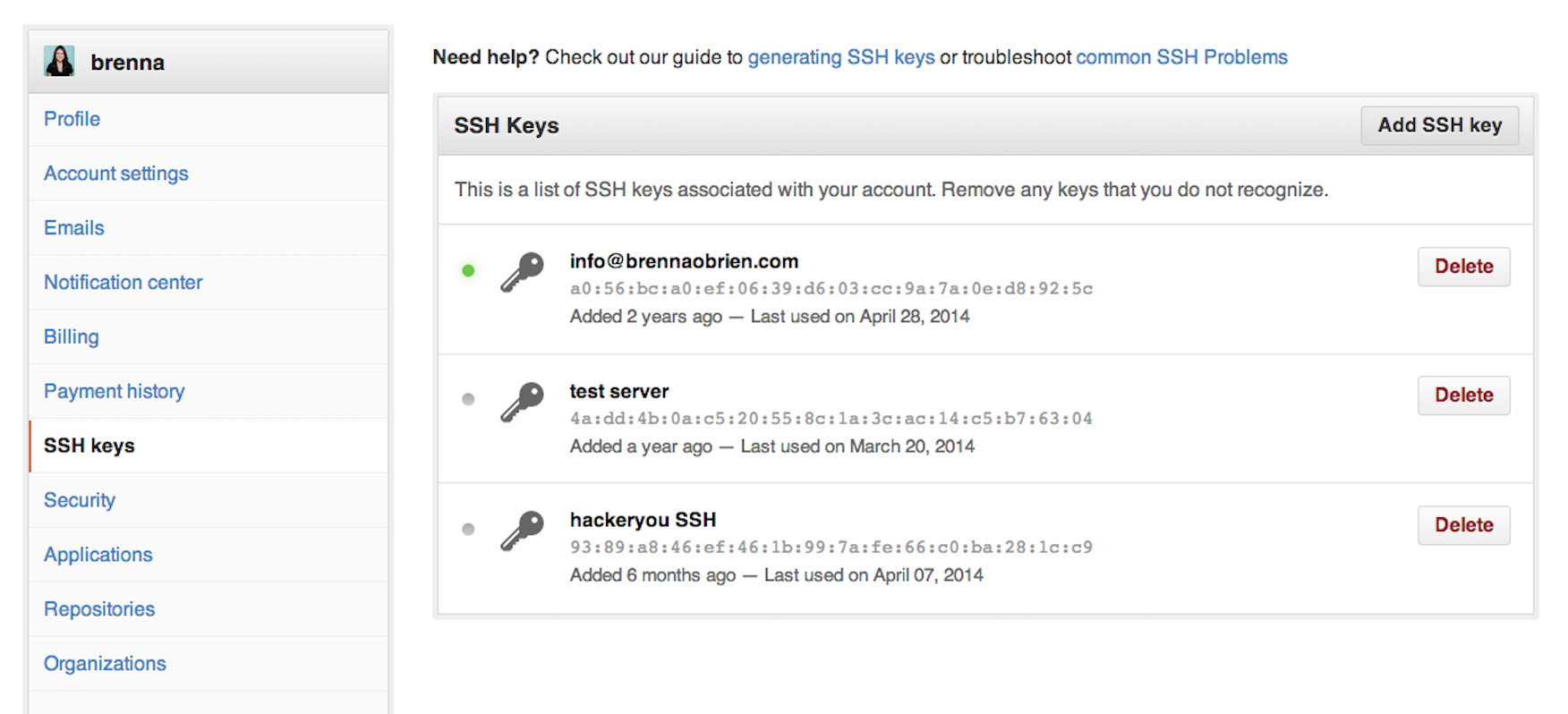Quick steps: Create and use an SSH public-private key pair for Linux VMs in Azure.; 4 minutes to read +4; In this article. With a secure shell (SSH) key pair, you can create virtual machines (VMs) in Azure that use SSH keys for authentication, eliminating the need for passwords to sign in. Aug 07, 2019 How to set up SSH keys. Steps to setup secure ssh keys: Create the ssh key pair using ssh-keygen command. Copy and install the public ssh key using ssh-copy-id command on a Linux or Unix server. Add yourself to sudo or wheel group admin account. Disable the password login for root account. Creating an SSH key on Windows 1. Check for existing SSH keys. You should check for existing SSH keys on your local computer. You can use an existing SSH key with Bitbucket Server if you want, in which case you can go straight to either SSH user keys for personal use or SSH access keys for system use. Open a command prompt, and run. Jul 24, 2019 Run the ssh-keygen command to generate a SSH key. Just press enter when it asks for the file, passphrase, same passphrase. Just press enter when it asks for the file, passphrase, same passphrase. It generates a pair of keys in /.ssh directory by default. Dec 07, 2019 What is SSH Key? How To Generate SSH Key in Linux? Enter the following command in terminal to create the Key pair. Ssh-keygen -t rsa. Store the Keys and Passphrase. You will be prompted for a location to save the keys and provide a passphrase for the keys. This passphrase will protect your private key while it’s stored on the hard drive. Nov 10, 2011 4. Your public and private SSH key should now be generated. Open the file manager and navigate to the.ssh directory. You should see two files: idrsa and idrsa.pub. Upload the idrsa.pub file to the home folder of your remote host (assuming your remote host is running Linux as well).
How do I generate ssh RSA keys under Linux operating systems?
You need to use the ssh-keygen command as follows to generate RSA keys (open terminal and type the following command):ssh-keygen -t rsa
ORssh-keygen
Sample outputs:
The -t type option specifies the type of key to create. The possible values “rsa†or “dsa†for protocol version 2. The $HOME/.ssh stores the following two files:
- $HOME/.ssh/id_rsa – Your private RSA key
- $HOME/.ssh/id_rsa.pub – Your public RSA key

Please do not share keys file with anyone else. You can upload keys to remote server as follows:ssh-copy-id userName@server2.nixcraft.net.in
Finally, you can login to remote server as follows:ssh userName@server2.nixcraft.net.in
scp file.txt userName@server2.nixcraft.net.in:~/data2/
See also:
- Howto Linux / UNIX setup SSH with DSA public key authentication (password less login)
- sshpass: Login To SSH Server / Provide SSH Password Using A Shell Script
- keychain: Set Up Secure Passwordless SSH Access For Backup Scripts
ADVERTISEMENTS
This page explains a public key and shows you how to set up SSH keys on a Linux or Unix-like server. I am assuming that you are using Linux or Unix-like server and client with the following software:
- OpenSSH SSHD server
- OpenSSH ssh client and friends on Linux (Ubuntu, Debian, {Free,Open,Net}BSD, RHEL, CentOS, MacOS/OSX, AIX, HP-UX and co).
What is a public key authentication?
OpenSSH server supports various authentication schema. The two most popular are as follows:
- Passwords based authentication
- Public key based authentication. It is an alternative security method to using passwords. This method is recommended on a VPS, cloud, dedicated or even home based server.
How to set up SSH keys
Steps to setup secure ssh keys:
- Create the ssh key pair using ssh-keygen command.
- Copy and install the public ssh key using ssh-copy-id command on a Linux or Unix server.
- Add yourself to sudo or wheel group admin account.
- Disable the password login for root account.
- Test your password less ssh keys login using ssh user@server-name command.

Let us see all steps in details.
How do I set up public key authentication?
You must generate both a public and a private key pair. For example:
Where,
- server1.cyberciti.biz – You store your public key on the remote hosts and you have an accounts on this Linux/Unix based server.
- client1.cyberciti.biz – Your private key stays on the desktop/laptop/ computer (or local server) you use to connect to server1.cyberciti.biz server. Do not share or give your private file to anyone.
In public key based method you can log into remote hosts and server, and transfer files to them, without using your account passwords. Feel free to replace server1.cyberciti.biz and client1.cyberciti.biz names with your actual setup. Enough talk, let’s set up public key authentication. Open the Terminal and type following commands if .ssh directory does not exists:
1: Create the key pair
On the computer (such as client1.cyberciti.biz), generate a key pair for the protocol.
Sample outputs:
You need to set the Key Pair location and name. I recommend you use the default location if you do not yet have another key there, for example: $HOME/.ssh/id_rsa. The sims 3 outdoor living stuff key generator. You will be prompted to supply a passphrase (password) for your private key. I suggest that you setup a passphrase when prompted. You should see two new files in $HOME/.ssh/ directory:
- $HOME/.ssh/id_rsa– contains your private key.
- $HOME/.ssh/id_rsa.pub – contain your public key.
Optional syntax for advance users
The following syntax specifies the 4096 of bits in the RSA key to creation (default 2048):$ ssh-keygen -t rsa -b 4096 -f ~/.ssh/vps-cloud.web-server.key -C 'My web-server key'
Where,
- -t rsa : Specifies the type of key to create. The possible values are “rsa1” for protocol version 1 and “dsa”, “ecdsa”, “ed25519”, or “rsa” for protocol version 2.
- -b 4096 : Specifies the number of bits in the key to create
- -f ~/.ssh/vps-cloud.web-server.key : Specifies the filename of the key file.
- -C 'My web-server key' : Set a new comment.
2: Install the public key in remote server
Use scp or ssh-copy-id command to copy your public key file (e.g., $HOME/.ssh/id_rsa.pub) to your account on the remote server/host (e.g., nixcraft@server1.cyberciti.biz). To do so, enter the following command on your client1.cyberciti.biz:
OR just copy the public key in remote server as authorized_keys in ~/.ssh/ directory:
A note about appending the public key in remote server
On some system ssh-copy-id command may not be installed, so use the following commands (when prompted provide the password for remote user account called vivek) to install and append the public key:
3: Test it (type command on client1.cyberciti.biz)
The syntax is as follows for the ssh command:
Or copy a text file called foo.txt:
You will be prompted for a passphrase. To get rid of passphrase whenever you log in the remote host, try ssh-agent and ssh-add commands.
What are ssh-agent and ssh-add, and how do I use them?
To get rid of a passphrase for the current session, add a passphrase to ssh-agent and you will not be prompted for it when using ssh or scp/sftp/rsync to connect to hosts with your public key. The syntax is as follows:
Type the ssh-add command to prompt the user for a private key passphrase and adds it to the list maintained by ssh-agent command:
Enter your private key passphrase. Now try again to log into user@server1.cyberciti.biz and you will not be prompted for a password:
One can list public key parameters of all identities with the -L option:ssh-add -L
Deleting all private keys from the ssh-agent can be done with the -D option as follows:ssh-add -D
When you log out kill the ssh agent, run:kill $SSH_AGENT_PID
You can also add something like the below to your shell startup to kill ssh-agent at logout:trap 'kill $SSH_AGENT_PID' 0
4: Disable the password based login on a server
Login to your server, type:
Edit /etc/ssh/sshd_config on server1.cyberciti.biz using a text editor such as nano or vim:
Warning: Make sure you add yourself to sudoers files. Otherwise you will not able to login as root later on. See “How To Add, Delete, and Grant Sudo Privileges to Users on a FreeBSD Server” for more info.
$ sudo vim /etc/ssh/sshd_config
OR directly jump to PermitRootLogin line using a vim text editor:$ sudo vim +/PermitRootLogin /etc/ssh/sshd_config
Find PermitRootLogin and set it as follows:
Save and close the file. I am going to add a user named vivek to sudoers on Ubuntu Linux:# adduser vivek
Finally, reload/restart the sshd server, type command as per your Linux/Unix version:
5: How to add or replace a passphrase for an existing private key?
To to change your passphrase type the following command:ssh-keygen -p
6: How do I backup an existing private/public key?
Just copy files to your backup server or external USB pen/hard drive:
Generate Ssh Public Key
How do I protect my ssh keys?
- Always use a strong passphrase.
- Do not share your private keys anywhere online or store in insecure cloud storage.
- Restrict privileges of the account.
How do I create and setup an OpenSSH config file to create shortcuts for servers I frequently access?
See how to create and use an OpenSSH ssh_config file for more info.
Mac Generate Ssh Key
Conclusion
This page explained how to set up ssh keys for authentication purposes. For more info see the following resources:
- Man pages – ssh-keygen(1)
- OpenSSH project homepage here.
And, there you have it, ssh set up with public key based authentication for Linux or Unix-like systems.
Command To Generate Ssh Key Pair In Linux
ADVERTISEMENTS
Top News
- ✔ Bulk Generation Of Waybill Keys
- ✔ Microsoft Office 365 Product Key Generator 2018
- ✔ Generate Ca Certificate From Ca Key
- ✔ Steam Keys Generator Online No Survey
- ✔ Wifi Key Generator Software Free Download
- ✔ Guild Wars 2 Cd Key Generator No Survey
- ✔ Generator Cd Key Windows 7
- ✔ Ssh Generate Key Windows Amazon Aws Sftp
- ✔ Generate Public Key And Private Key Ssh
- ✔ Subway Surfers Unlimited Coins And Keys Generator Apk